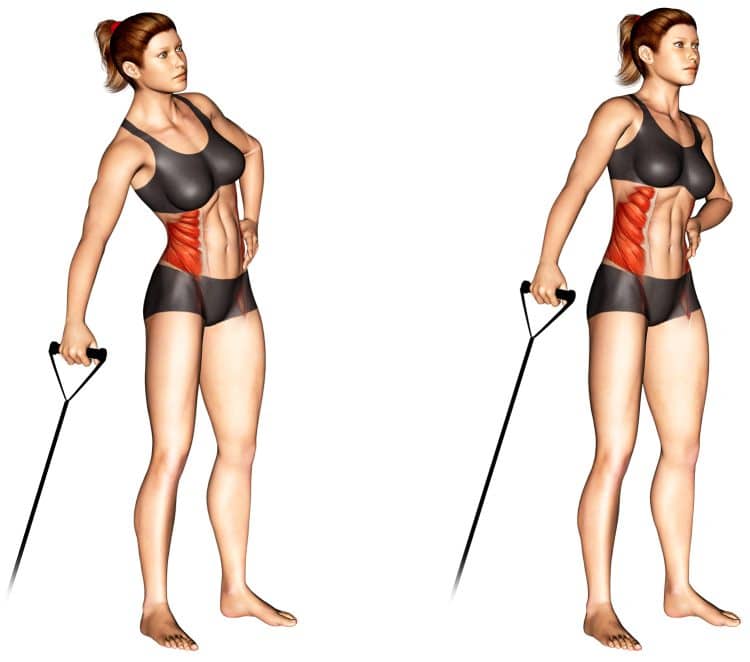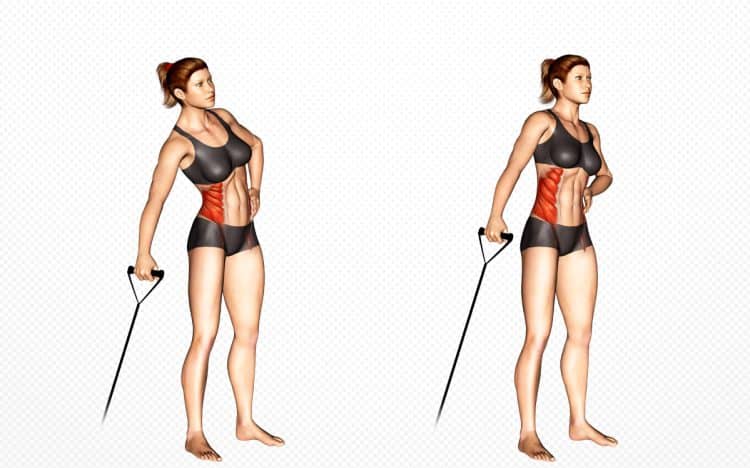When you’re bored of those lying and sitting side crunch variations or ran out of options to train your obliques at home, then it’s time to step it up (Literally) with the band side bend! It’s the elastic version of an old-school dumbbell variant where you tilt from side to side holding weights. Back in the day, bodybuilders would incorporate heavy side bends to bulk up the larger, and incredibly meaty lower region of the obliques, where fat tends to accumulate overtop the muscle, hence giving birth to the term “love handles”.
And for your information, side bends won’t burn that fat, but it’ll develop the muscle underneath which is what we want to do. Then you’ll need to incorporate a negative energy balance to lean up if that’s your goal.
Muscles Worked During The Band Side Bend
If not rather obvious by now, the purpose of a side bend is to bring out the muscles on either side of your belly. Overshadowed by its more central counterpart, a sexy midsection requires an aesthetic component from the obliques. Additionally, you’ll get a little hip motion in there too.

Here you can learn where these muscles are, what they do, and why they’re important.
Obliques
The second most famous name in the midsection, obliques fit on the anterolateral part of the midsection, appearing like slabs of ribs on either side of the middle abdominal muscles. We have external obliques that angle downward toward the groin, and internal obliques with perpendicular fibers. They have two different functions.
- External – Because they’re angled inward, their fiber direction twists the trunk from left to right.
- Internal – Formed going in the opposite direction, the internal obliques hence flex the torso or bends the upper body sideways.
Iliopsoas
Call it the big three if you like, but the iliacus, psoas major, and psoas minor are the ones doing the heavy flexing when it comes to the hip joint. Iliacus and psoas are separate muscles in the abdomen but form together in the thigh, and can function individually and together.
How To Do The Band Side Bend
Band side bends are a simple concept that replicate standing oblique crunches. But as with almost any exercise, you may need to adjust the technique until it feels right for you, even if given specific instructions, or shown a video example. The most important thing is to feel the muscles working against your chosen resistance without pain or discomfort.
So we’ve included step by step instructions and two different band side band variations.
Steps
- Attach your band down low to a door anchor, the bottom of an exercise rack, or similar sturdy object.
- Grasp the band in your left hand then stand sideways so the left side of your body facing the anchor point, or vice versa if you want to start on the opposite side.
- Stand with your feet slightly wider than the shoulders, and you can either keep them straight, or slightly bent.
- Stand tall, then bend down towards your right side and perform a crunch with the same oblique muscles. Stop when there’s no more motion in the trunk.
- Return to an upright position, then continue repping out until you’ve achieved the desired number of repetitions for the right side.
- Switch sides, now holding the band in your right hand, and bending towards your left side.
- Alternate sides until you’ve reached the prescribed number of sets.
If you don’t have a place to anchor your band, just step on it with your foot to achieve the same thing.
Tips
- Attach your anchor on the side of the door that closes shut so it won’t open on you. We also recommend locking your door for safety.
- Using a door anchor is advantageous in that you don’t need to anchor your bands down using your feet. This is also good for making progress as you can simply add another band for more resistance rather than adjust your foot position to increase or decrease the training load.
Benefits of The Band Side Bend
There are many reasons you should consider throwing in band side bands along your other core training movements.
Build a more impressive midriff
While the obliques will always be second best to the rectus abdominis when it comes to aesthetic appeal, every muscle contributes to a well-rounded physique. Therefore, you should spend as much time on your obliques as you do the front and center abdominals.
If you look at a lean bodybuilder, you’ll see how important the obliques are for creating a superhero-like core.
Functional core
Not just on display for the world to see, the obliques have a job, and its duty is to create rotation, and lateral flexion of our midsections. This is required for daily movement, sporting activities, and other types of physical performance.
While a large portion of exercisers ignore specific oblique training, we like that it brings attention to the lateral core. Because we’ll remember not just to train it, but also stretch these side facing muscles. It’s easy to pull a muscle in your torso, especially when you’re less active and then jump into activities that require intense rotation, twisting, and lateral bending.
That’s not even including the benefits of training while standing. We tend to only sit, lie, or hang to train our midsections, but for athletes especially, you should learn how to create muscular force on your feet. For example, in impact sports like football, opposition can hit you from various directions. A standing side bend not only strengthens the obliques but it’ll train you to contract and brace them to help absorb force and avoid injury.
Nice change from oblique crunches
Typically, lying side crunches have little competition when it comes to home ab workouts. They can get boring and unsatisfying after a while, and we also suggest having several options to keep things fun and fresh.
Common Mistakes During The Band Side Bend
The common mistakes are bad training habits that you don’t need.
Using too much range of motion
A common mistake when doing a one handed side bend is bending too much toward the side you’re not working. Sure, you can achieve a nice stretch this way, but no need to overexaggerate it.
Doing short reps
The obliques are capable of decent lateral flexion, yet some people use very short movements, not maximizing the potential of band side bends. You should be able to crunch with enough range of motion that you feel a strong contraction in the obliques.
Going too low intensity
You should add weight to your core muscles exercises as with any movement whether it’s using a weight, band, machine, or utilizing different body positions and the weight of your legs to increase the resistance. But, that’s if you are on a mission to significantly increase muscle size. Because bodyweight alone is enough to create a toned appearance without gaining too much bulk in your muscles.
Variations and Alternatives of The Band Side Bend
We could show you so many way to train the oblique muscles, but the following exercises are closely related or the best alternatives that we’d like to share with you. They’re all slightly but you’ll appreciate the variety and unique benefits offered by each one.
Band side crunches
A similar idea but with the band anchored above your head rather than low to the ground. Therefore, whatever side you hold the band is the side you train, unlike side bends, due to the band placement. Really both are great options though and why not combine them for variety and oblique gains?
Steps
- Attach your band overhead.
- Grab the band so that there’s tension and hold it next to the same side oblique muscles.
- Bend and crunch into your obliques then come back up.
Free weight side bend
An old-schoolesque variation of band side bends, typically performed using two dumbbells, it seems that we tend to avoid this movement nowadays. Likely because a long time ago we were told that it bulks up the obliques. However, that shouldn’t be the case especially if you’re not using max poundages.
It depends on your genetics too, as some people could use more bulkiness, or they may like it. Just stay in the recommended rep range and see how your gains are coming along.
Here’s a full guide on dumbbell side bends.
Cable side bend
If in a gym, cables are the obvious better choice for oblique training. From seeing the weight numbers on the machine stack to the even resistance of a solid cable without needing stretched, cable machines are sure to give you an amazing core workout.
Lying side crunches
Of course, you could always just go back to the basics, and hit your obliques with the classic, old-school lying side crunch. It’s still a very good movement, especially for beginners and intermediates who will benefit from improving their mind-muscle connection without using equipment, bands, or weights.
Band step outs
Rather simple (Not easy though) but if you have a band, this anti-rotational strength building oblique exercise is a must do!
- You’ll attach your band roughly shoulder height, stand sideways to the anchor point, and grasp the band in both hands with fingers interlaced and the arms extended forward. You’ll then step sideways and away from the base which increases the resistance but also challenges you to fight against rotation.
Russian twists
Russian twists are usually challenging enough that beginners and some intermediates don’t need any extra weight. You’re having to sit on your butt with the torso reclined which is what provides the resistance. Then you’ll rotate from side to side with the intention of using your obliques. Then when you get stronger, hold a weight or medicine ball, and those lateral core muscles will be burning!
Archer tucks
Another banger of an oblique exercise and one that incorporates the weight of your legs unlike the other options you’ll find here. You need some bottom up action to really maximize your oblique development, and archer tucks are bodyweight only which is a big advantage.
Steps
- Start by sitting on the floor, and use your arms to hold yourself up as you get into position and perform the movement.
- Now lean back and shift your body on the left butt cheek, then pull both knees into your stomach to contract the right side obliques.
- Immediately roll to your right butt cheek, then draw the legs into your left obliques.
Or you can perform all reps on one side then switch to the next instead of alternating side in a single set. Here’s a demonstration.
FAQ’s
What's the best sets and reps for band side bends?
It depends on your goals. For bulkier obliques you can incorporate heavier resistance and fewer reps, or stick with moderate and higher reps for slight muscle gain improvements.
Can I use any type of resistance band for this exercise?
Yes. Any good quality, standard length training resistance band will do. Just make sure it’s properly anchored, and provides the desired amount of resistance to challenge you in various rep ranges.
Related: Best Ways To Get Rid Of Stubborn Love Handles!
Wrapping Up
If you wondered what else you could do to train your obliques besides floor side crunches and abdominal twists, then the band side crunch offers something that these other movements don’t. A standing lateral core technique that can be loaded with the convenience of elastic training bands to gain bulk or create a sexier “V” shape to your midriff.
You see, exercising on your feet teaches you to utilize your body together to engage your muscles which has functional, and athletic benefits. While promoting attention to an undervalued muscle group that plays a role in well-being, commonly strained from lack of activity, then sudden movements. Therefore, we really like incorporating these types of exercises for the holistic advantages!


